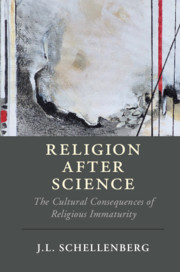Book contents
- Religion After Science
- Cambridge Studies in Religion, Philosophy, and Society
- Religion After Science
- Copyright page
- Dedication
- Contents
- Acknowledgments
- Prologue: The 10,000-Year Test
- 1 Development and the Divine
- 2 The End Is Not Near
- 3 Big Ambitions
- 4 A Poor Record
- 5 Verdict: Immature, Not Doomed
- 6 A New Path for Science and Religion
- 7 The New Agnosticism
- 8 Naturalism Tamed
- 9 Agnostic Religion?
- 10 The New Humanism
- Epilogue: The Religion Project
- Notes
- Index
7 - The New Agnosticism
Published online by Cambridge University Press: 09 August 2019
- Religion After Science
- Cambridge Studies in Religion, Philosophy, and Society
- Religion After Science
- Copyright page
- Dedication
- Contents
- Acknowledgments
- Prologue: The 10,000-Year Test
- 1 Development and the Divine
- 2 The End Is Not Near
- 3 Big Ambitions
- 4 A Poor Record
- 5 Verdict: Immature, Not Doomed
- 6 A New Path for Science and Religion
- 7 The New Agnosticism
- 8 Naturalism Tamed
- 9 Agnostic Religion?
- 10 The New Humanism
- Epilogue: The Religion Project
- Notes
- Index
Summary
Since 2006, a band of merry men, the new atheists, has been rampaging across the science-and-religion landscape. Often these men seem angry, but really, and none too secretly, they enjoy sticking it to religion. Their approach – too impatient and confident to abide much reasoning, at least absent a healthy dollop of sarcasm – is not calculated to win the affection of serious thinkers. But serious thought is not what the new atheism is really about; serious thought is altogether too serious and also too timid for many new atheists. As to timidity, this tends to be what the new atheists suspect of anyone who would rather be called ‘agnostic.’ A term devised to describe himself by Thomas Huxley – Darwin’s bulldog, not exactly a timid type – ‘agnostic’ reeks to many of faltering indecision.
- Type
- Chapter
- Information
- Religion after ScienceThe Cultural Consequences of Religious Immaturity, pp. 81 - 90Publisher: Cambridge University PressPrint publication year: 2019

